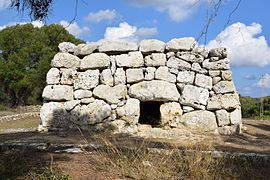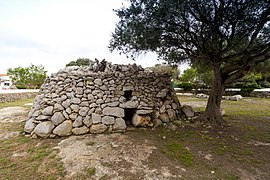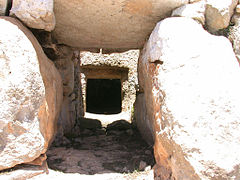Naveta
Navetas are prehistoric grave sites , exclusively from to Spain belonging to the Balearic island of Menorca are known. The buildings made of large stones date from 1130 to 820 BC. BC, although there is evidence that the first Navetas as early as 1300 BC. Were erected. Its greatest use falls in the prototalayotic phase from 1050 to 850 BC. Chr.
description
The buildings belong to the semi- megalithic cult complexes, although they were built much later as continental equivalents. The navetas of Rafal Rubí near Alaior and the navetas of Biniac are among the well-preserved ones . Outstanding is composed of limestone blocks built Naveta des Tudons in Ciutadella to the west of the island of Menorca. It measures 13.6 meters x 5.85 meters on the outside and is 4.5 meters high. The original height was probably 6.0 meters.
The forerunner of the Naveta is the Protonaveta , a round grave structure with triple walls and an oval interior, which in turn represents a further development of the local dolmen . This development did not take place on Mallorca, which - unlike Menorca - has only a few dolmens. Protonavetas can be found in Ses Arenes de Baix and Son Olivaret, for example.
- Navetas
shape
The naveta is usually in the shape of an overturned ship , which is where its name comes from. It is rounded apsidal on the bow and blunt on the stern, where its only access is. The narrow, flat roof does not end in a pointed keel , but is closed by large panels. Starting from the ground, it tapers in a tholos-like manner like a cantilever vault . But there are also navetas with a round cross-section. In general, the structure of navetas varies greatly. They can have built-in components and be horizontally divided inside, with a shaft open at the top connecting the lower and upper chambers. The interiors of the navetas are elongated oval.
The chambers of the Naveta des Tudons contained the skeletal remains of about 100 people, including a trepanned skull . The accompanying finds such. B. Bronze bracelets are exhibited in the Museu de Menorca in Mahon .
Demarcation
The also ship-shaped houses of the 2nd millennium on Mallorca and Menorca are called Naviformes or Navetiformes.
literature
- José Simón Gornés Hachero: Sociedad y cambio en Menorca: sistematización de los contextos arqueológicos de las navetas funerarias between 1400 and 850 CAL ANE . Dissertation, Universitat Autònoma de Barcelona 2016, ISBN 978-84-490-6612-2 ( full text online PDF, 1063 pages in 4 files, Spanish).
- Sylvia Gili, Vicente Lull, Rafael Micó, Cristina Rihuete, Roberto Risch: An island decides: megalithic burial rites on Menorca (PDF; 448 kB). In: Antiquity 80, 2006, pp. 829-842 (English).
- Robert Chapman, Annie Grant: Prehistoric subsistence and monuments in Mallorca . In: Mirian S. Balmuth (Ed.): Encounters and transformations: The archeology of Iberia in transition. Sheffield: Sheffield Academy Press, ISBN 978-1-85075-593-7 (English).
- Sibylle von Reden: The Megalithic Cultures. DuMont, Cologne 1978, 1982, ISBN 3-7701-1055-2 .
- Jürgen E. Walkowitz: The megalithic syndrome. European cult sites of the Stone Age (= contributions to the prehistory and early history of Central Europe. Vol. 36). Beier & Beran, Langenweißbach 2003, ISBN 3-930036-70-3 .
Web links
- Navetas in Mallorca
- Naveta des Tudons on www.menorcaweb.com
- A little history of spanish Architecture: Navetas on www.spanisharts.com (English)
Individual evidence
- ^ Rafael Micó: Radiocarbon Dating and Balearic Prehistory: Reviewing the Periodization of the Prehistoric Sequence . In: RADIOCARBON 48 (No. 3), 2006, pp. 421-434.
- ^ Antoni Nicolau Martí, Elena Sintes Olives, Ricard Pla Boada, Albert Àlvarez Marsal: Talayotic Minorca . The prehistory of the island. Triangle Books, Sant Lluís 2015, ISBN 978-84-8478-640-5 , pp. 40 (English).
- ^ Antoni Nicolau Martí, Elena Sintes Olives, Ricard Pla Boada, Albert Àlvarez Marsal: Talayotic Minorca . The prehistory of the island. Triangle Books, Sant Lluís 2015, ISBN 978-84-8478-640-5 , pp. 90 (English).
- ↑ Sylvia Giliet al .: An island decides: megalithic burial rites on Menorca. 2006 (English).
- ↑ Son Olivaret tomb on the Menorca Talayótica website, accessed on October 10, 2015.





